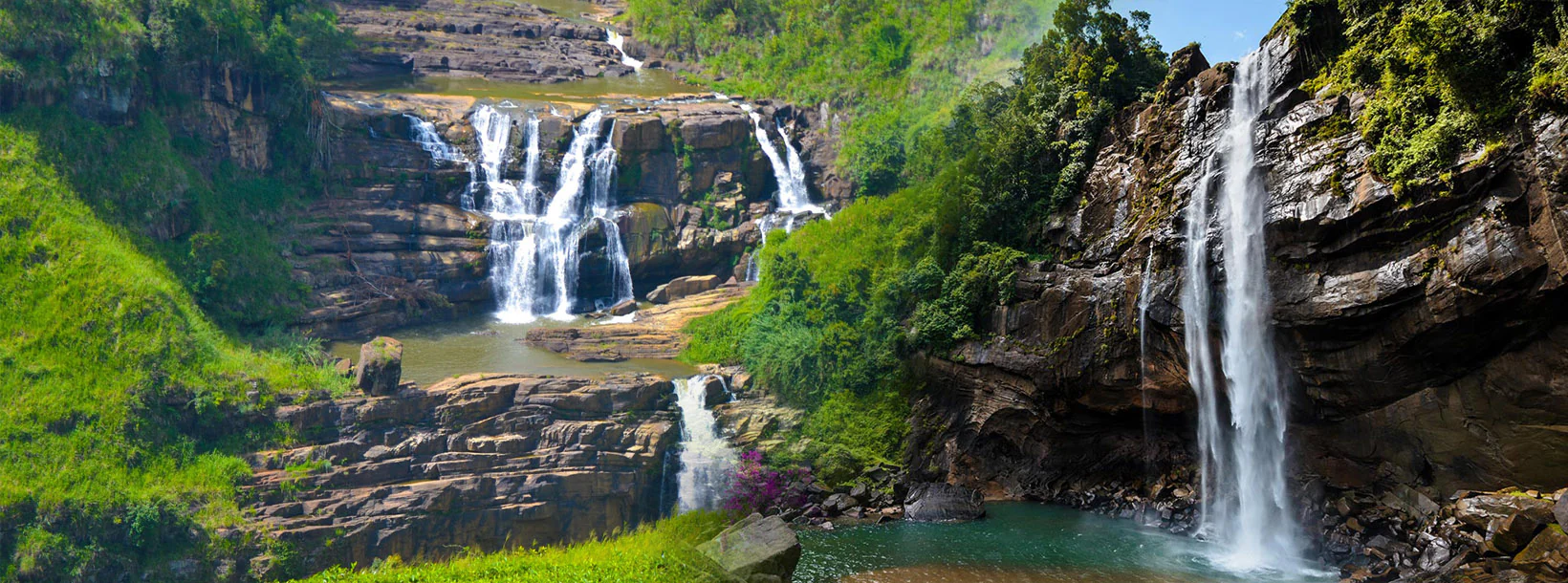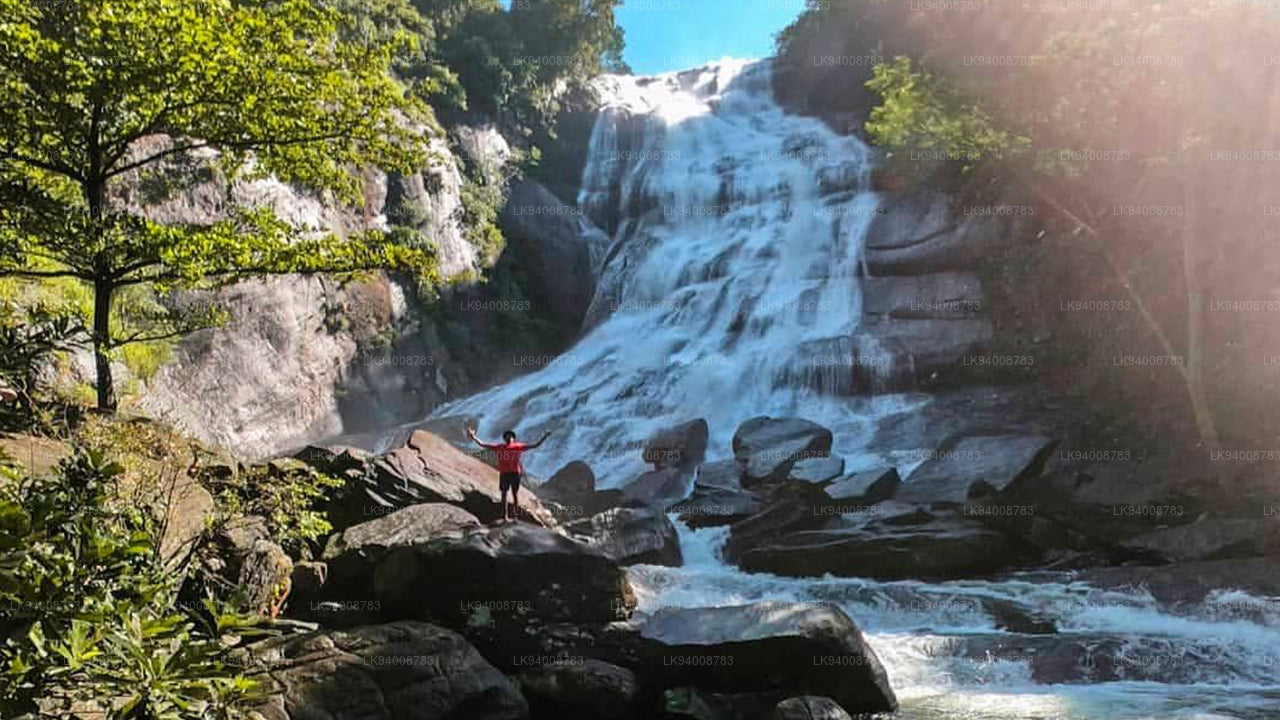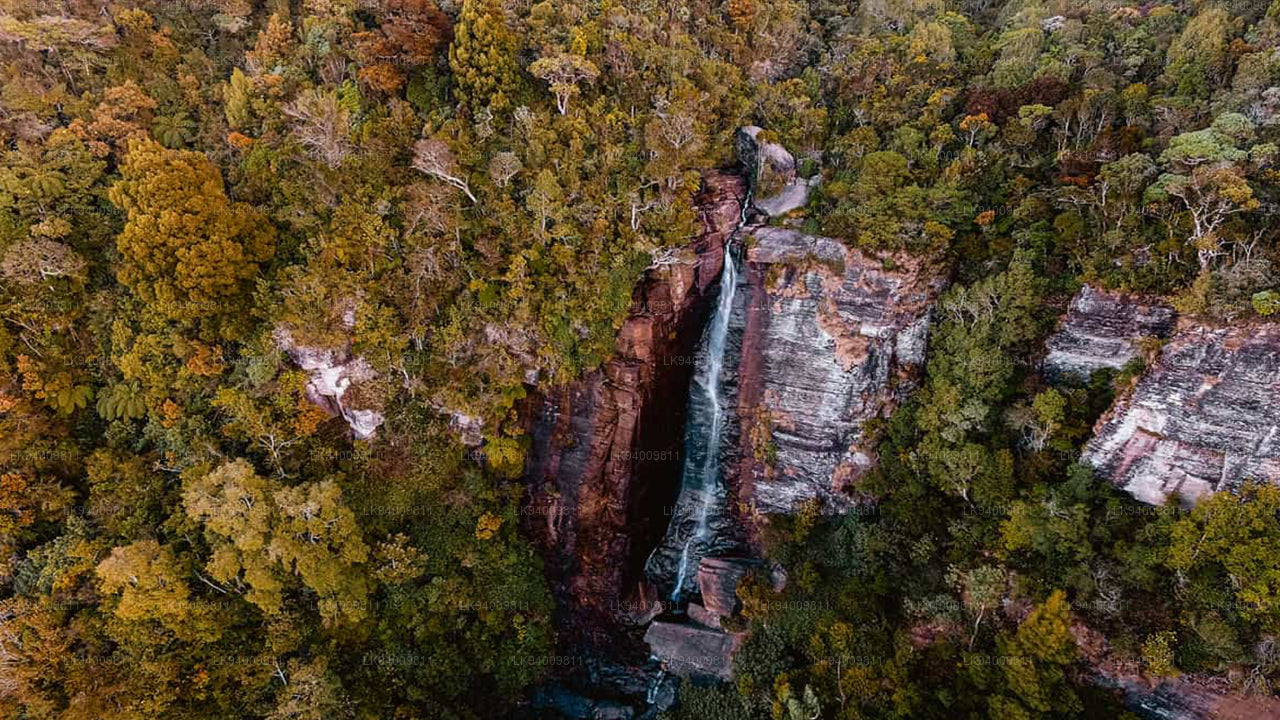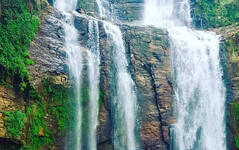
Waterfalls
Having the highest waterfall density in the world with a recorded 382 waterfalls spread throughout the country, Sri Lanka is the place to be to see all kinds of waterfalls.Fed by two half-yearly monsoons, rivers rush down the rocky precipices and form spectacular waterfalls. Only some of these picturesque waterfalls can be viewed with ease as the others are located inside thick forests and around tea plantations.
Ramboda Falls
Ramboda Falls, located in the picturesque central highlands of Sri Lanka, near the town of Ramboda, is one of the island's tallest and most majestic waterfalls. Situated along the Pussellawa area of the Kandy District, this waterfall is a significant and striking natural feature that draws visitors from around the world.
The waterfall boasts a dramatic drop of approximately 109 meters, cascading in a breathtaking display of water and mist. The journey to Ramboda Falls is marked by scenic vistas and lush greenery, making it a popular spot for photographers and nature lovers. The surrounding environment is rich with exotic vegetation and offers a refreshing cool climate, enhancing the experience of all who visit.
Visitors to Ramboda Falls can enjoy the views from a well-positioned viewpoint that allows for stunning photographs and the opportunity to witness the sheer scale of the waterfall. Nearby, there are facilities for visitors to relax and soak in the natural beauty of the area, including several small cafes and resting spots.
Ramboda Falls is not just a visual spectacle; it is also an accessible destination for those looking to explore the natural wonders of Sri Lanka. The area provides pathways and viewing decks that ensure a safe and enriching experience for all visitors, making it a must-see location for anyone traveling through the central highlands.
-
 Bakers Falls
Bakers FallsThe Baker’s Falls in the Horton Plains gets its water from the Belihul Oya. It is close to World’s End.
-
 Bambarakanda Ella
Bambarakanda EllaThe tallest is the Bambarakande Falls which cascades down 263 meters like liquid light. It is only four miles away from the Colombo-Bandarawela road.
-
 Bopath Ella
Bopath Ella“Bopath Ella”, not like many of the others of her kind, finds her abode in a busy surrounding in the village called Devipahala off Kuruwita on A4 High-Level road close to Ratnapura.
-
 Devon Falls
Devon FallsWith a peculiar appearance imparted to it by its formation in three continuous cascades this waterfall christened “Devon Falls” pours down to the valley beneath not a long distance away from its brother the “St. Clairs”.
-
 Diyaluma Falls
Diyaluma FallsAt the peak of Diyaluma Falls in Sri Lanka, you will find a serene natural infinity pool overlooking a 772-foot (220-metre) waterfall. Located near the town of Koslanda in the Badulla District.
-
 Dunhinda Falls
Dunhinda Falls“Dunhinda” is one of the most spoken-about waterfalls in Sri Lanka. Although she couldn’t come even close to the highest waterfalls of the planet in height she rivals many of them when it comes to the natural beauty that it bestows on the environment.
-
 Kirindi Ella
Kirindi EllaKirindi Ella is a waterfall in the southern foothills of Sri Lanka’s central highlands, in only 6.5 km distance from the main junction in Pelmadulla.
-
 Mapanana Ella
Mapanana EllaThe Mapalana waterfall lies in the remote hamlet of Mapalana on the shadows of theSri Padamountain range. Mapalana can be reached by foot from Palabaddala.
-
 Olu Ella
Olu EllaOlu Ella is situated in Yatiyantota town of Kegalle district. It stands at a height of 127 meters and is the 6th tallest waterfall of Sri Lanka.
-
 Rawana Ella
Rawana EllaIn the misty mountains of tropical Sri Lanka, the wide Ravana falls gushes down a height of 82 feet falling from an oval concave rock.
-
 Rikilla Ella
Rikilla EllaBulathkohupitiya is a small town hidden among the mountains of the hill country. From there, on the way to Dedugala can be seen this waterfall in a very serene landscape.
-
 St Clair's Falls
St Clair's FallsThese majestic “St.Clairs” falls are close to the main road from Avissawella to Nuwara-Eliya and can well be seen from the Main Line rail track close to Talawakelle.
-
 Lovers Leap Fall
Lovers Leap FallThe 100 feet high Lovers Leap begins its journey as a fountain at the Southern slope of Sri Lanka`s highest mountain Pidurutalagala. The falls can be seen from the town Nuwara Eliya.
-
 Galagediyana Ella
Galagediyana EllaThis waterfall is very close to Colombo can be reached off Dedigama where the famous Kotavehera Dagaba.
-
 Ramboda Falls
Ramboda FallsA gigantic waterfall having three parts and very close to the 53km post along the above A-5 trunk road.
-
 Poona Ella Falls
Poona Ella FallsPoona Ella Falls or Ramboda Ella Falls height is 109 m (358 ft), and two waterfalls are starting from two destinations merge into one at the bottom.
-
 Hellboda Ella Falls (Ramboda)
Hellboda Ella Falls (Ramboda)This is by the side of A-5 trunk route Kandy to Nuwara Eliya east of Pussellawa.
-
 Bomburu Ella Waterfall
Bomburu Ella WaterfallPair text with an image to focus on your chosen product, collection, or blog post. Add details on availability, style, or even provide a review.
-
 Dhuwili Waterfalls
Dhuwili WaterfallsDhuwili Ella of Balangoda Sri Lanka is a very high and a beautiful waterfall in Sri Lanka. Dhuwili Ella is at Kalthota which is Hambegambuwa road of Balangoda.
-
 Kotaganga Ella Falls
Kotaganga Ella FallsThe Kota Ganga Ella Falls (Kota Ganga Ella) is a cluster of cascading waterfalls in the Knuckles Mountain Range in the Kandy District. The cluster consists of at least 7 major segments.
-
 Wedamulla falls
Wedamulla fallsThis waterfall is 30 meters high and flows fast over a rock wall and falls into the Kotmale Reservoir. Palagolla Falls is located near the village of Wedamulla in the Palagolla area.
-
 Galboda Falls
Galboda FallsGalboda Falls (ගල්බොඩ ඇල්ල) is a waterfall in Sri Lanka. It is located by Nuwara Eliya District. Galboda is an isolated village located in between Nawalapitiya and Watawala, in the Colombo-Badulla, the upcountry railway.
-
 Sera Ella Falls
Sera Ella FallsSera Ella (Sinhala:සේර ඇල්ල) is a waterfall located in Pothatawela village, a place near Laggala in the Matale District of Sri Lanka. It is formed by the waters of Kitul Canal which runs down Kaudagammana peak and the Hunumadala River
-
 Galgediyana Ella Falls
Galgediyana Ella FallsThe Galgediyana EllaWaterfall, in Gurugoda Oya (river), is mere 5m high but 50m wide. Located in the Kegalle District, if approaching from Morontota town, continue for 3km – the fall lies between Parambe and the Hunugal Estates.
-

Lankagama Duwili Ella Falls
Lankagama Duwili Ella FallsLankagama Duwili Ella Falls, nestled in Sinharaja Rainforest, is a stunning waterfall with cascading waters and misty spray, offering a serene, untouched paradise for nature lovers and adventure seekers.































